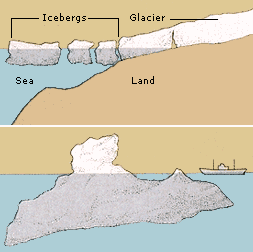World Book at NASA
 |
|
Icebergs form where chunks of ice break away from a glacier as it flows into the sea. The sun and wind melt the top of an iceberg. The bottom, which is under water, melts much more slowly. As the top melts away, leaving the bottom hidden beneath the surface, the iceberg becomes extremely dangerous to ships. Image credit: World Book diagrams by Marion Pahl |
Explorers have written vivid descriptions of the color and beauty of icebergs, and compared them to towers, spires, pyramids, cathedrals, and palaces. Large icebergs weigh more than 1 million tons (910,000 metric tons), and some are many miles or kilometers long. The biggest ones tower as much as 400 feet (120 meters) above the surface of the ocean. But this is only a small part of the whole iceberg. Only one-seventh to one-tenth of the iceberg's total mass is above water.
The white color of icebergs is caused by tiny, closely spaced gas cavities throughout the ice. When the sun is shining, streams of water form on the slopes of icebergs and drop over their edges in waterfalls. Icebergs often carry away large boulders and quantities of gravel from their glaciers. These are carried for long distances and finally dumped in the sea when the iceberg melts.
North Atlantic icebergs come from the island of Greenland. A huge ice sheet covers nearly all of Greenland. It has an area of about 672,000 square miles (1,740,000 square kilometers) and an average thickness of 5,000 feet (1,500 meters). Long tongues of ice extend from the edge of this ice sheet into the sea. Cracks in the ice, and the action of rough sea waves, cause the icebergs to break off from the ice tongues. Noises like great explosions and rolling thunder accompany the beginning of an iceberg as it cracks loose. If the iceberg drops into an enclosed bay, it may cause huge waves.
Most of the icebergs in the North Atlantic drift across Baffin Bay and Davis Strait to the coast of Labrador. Some of them are carried by the wind and the Labrador Current through the Newfoundland Banks into the Atlantic Ocean. In this region of the ocean, the icebergs melt rapidly because of the sunshine and warm ocean water. Parts of the icebergs may break off to form bergy bits, which are the size of an average house, or smaller pieces called growlers. Growlers are named for the noise they make as they float in the waves. Icebergs disappear about 400 miles (640 kilometers) south of Newfoundland.
The greatest numbers of icebergs reach the routes of transatlantic liners in April, May, and June. That is why ships crossing the Atlantic follow a more southerly course during these months.
Antarctic icebergs
Many icebergs drift out to sea from the great Antarctic ice sheets. Some of these icebergs are many times larger than those found in the North Atlantic. The largest one ever seen in the Antarctic region had a length of about 200 miles (320 kilometers) at its longest point and a width of about 60 miles (97 kilometers) at its widest point. It covered about 5,000 square miles (13,000 square kilometers). Icebergs that are 10 miles (16 kilometers) long are common in the Antarctic. In contrast, the largest iceberg measured in the North Atlantic was 4 miles (6.4 kilometers) long.
Ice patrols
Icebergs can be extremely dangerous to ships. One of the greatest sea disasters in history was the sinking of the Titanic during the night of April 14 and 15, 1912. The Titanic was the largest ship afloat then, and was on its first trip from England to New York. The ship struck an iceberg, and about 1,500 people died.
The wreck of the Titanic led to the establishment of an International Ice Patrol along the North Atlantic ship lanes. Since 1914, the patrol has been maintained through a sharing of its expenses by the principal shipping nations of the world. The United States Coast Guard does the actual patrolling. The patrol reports the position of icebergs and estimates their probable courses. Planes, ships, and satellites are used in patrolling.
There is little human beings can do to control icebergs. It is difficult to destroy an iceberg by blasting, or to steer it into a different course which would take it out of an ocean shipping lane. It is even difficult to approach an iceberg, because the submerged parts may tear open a ship's bottom.
Contributor: James E. Overland, Ph.D., Supervisory Oceanographer, Pacific Marine Environmental Laboratory, National Oceanic and Atmospheric Administration.
How to cite this article:
To cite this article, World Book recommends the following format:
Overland, James E. "Iceberg." World Book Online Reference Center. 2005. World Book, Inc. http://www.worldbookonline.com/wb/Article?id=ar271040.
| › Return to Topics | › Back to Top |